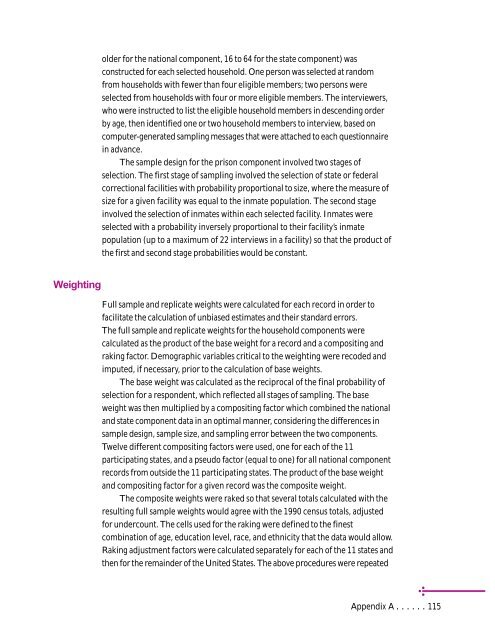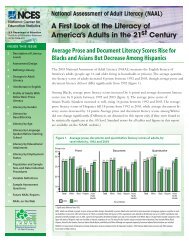Adult Literacy in America - National Center for Education Statistics ...
Adult Literacy in America - National Center for Education Statistics ...
Adult Literacy in America - National Center for Education Statistics ...
You also want an ePaper? Increase the reach of your titles
YUMPU automatically turns print PDFs into web optimized ePapers that Google loves.
Weight<strong>in</strong>g<br />
older <strong>for</strong> the national component, 16 to 64 <strong>for</strong> the state component) was<br />
constructed <strong>for</strong> each selected household. One person was selected at random<br />
from households with fewer than four eligible members; two persons were<br />
selected from households with four or more eligible members. The <strong>in</strong>terviewers,<br />
who were <strong>in</strong>structed to list the eligible household members <strong>in</strong> descend<strong>in</strong>g order<br />
by age, then identified one or two household members to <strong>in</strong>terview, based on<br />
computer-generated sampl<strong>in</strong>g messages that were attached to each questionnaire<br />
<strong>in</strong> advance.<br />
The sample design <strong>for</strong> the prison component <strong>in</strong>volved two stages of<br />
selection. The first stage of sampl<strong>in</strong>g <strong>in</strong>volved the selection of state or federal<br />
correctional facilities with probability proportional to size, where the measure of<br />
size <strong>for</strong> a given facility was equal to the <strong>in</strong>mate population. The second stage<br />
<strong>in</strong>volved the selection of <strong>in</strong>mates with<strong>in</strong> each selected facility. Inmates were<br />
selected with a probability <strong>in</strong>versely proportional to their facility’s <strong>in</strong>mate<br />
population (up to a maximum of 22 <strong>in</strong>terviews <strong>in</strong> a facility) so that the product of<br />
the first and second stage probabilities would be constant.<br />
Full sample and replicate weights were calculated <strong>for</strong> each record <strong>in</strong> order to<br />
facilitate the calculation of unbiased estimates and their standard errors.<br />
The full sample and replicate weights <strong>for</strong> the household components were<br />
calculated as the product of the base weight <strong>for</strong> a record and a composit<strong>in</strong>g and<br />
rak<strong>in</strong>g factor. Demographic variables critical to the weight<strong>in</strong>g were recoded and<br />
imputed, if necessary, prior to the calculation of base weights.<br />
The base weight was calculated as the reciprocal of the f<strong>in</strong>al probability of<br />
selection <strong>for</strong> a respondent, which reflected all stages of sampl<strong>in</strong>g. The base<br />
weight was then multiplied by a composit<strong>in</strong>g factor which comb<strong>in</strong>ed the national<br />
and state component data <strong>in</strong> an optimal manner, consider<strong>in</strong>g the differences <strong>in</strong><br />
sample design, sample size, and sampl<strong>in</strong>g error between the two components.<br />
Twelve different composit<strong>in</strong>g factors were used, one <strong>for</strong> each of the 11<br />
participat<strong>in</strong>g states, and a pseudo factor (equal to one) <strong>for</strong> all national component<br />
records from outside the 11 participat<strong>in</strong>g states. The product of the base weight<br />
and composit<strong>in</strong>g factor <strong>for</strong> a given record was the composite weight.<br />
The composite weights were raked so that several totals calculated with the<br />
result<strong>in</strong>g full sample weights would agree with the 1990 census totals, adjusted<br />
<strong>for</strong> undercount. The cells used <strong>for</strong> the rak<strong>in</strong>g were def<strong>in</strong>ed to the f<strong>in</strong>est<br />
comb<strong>in</strong>ation of age, education level, race, and ethnicity that the data would allow.<br />
Rak<strong>in</strong>g adjustment factors were calculated separately <strong>for</strong> each of the 11 states and<br />
then <strong>for</strong> the rema<strong>in</strong>der of the United States. The above procedures were repeated<br />
Appendix A ......115



